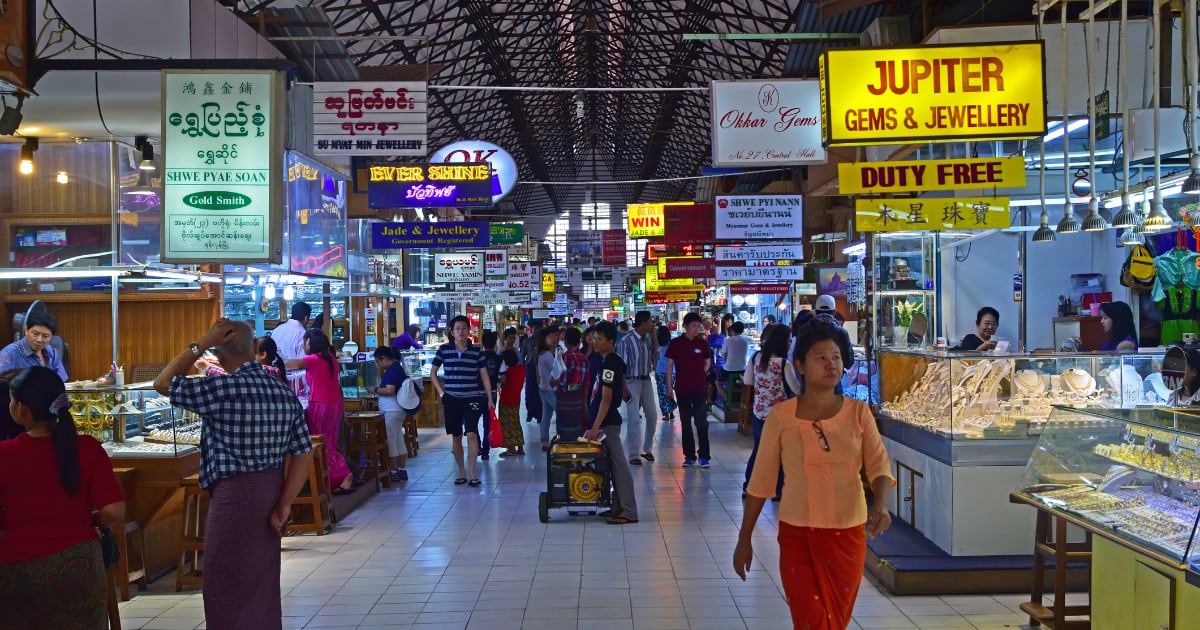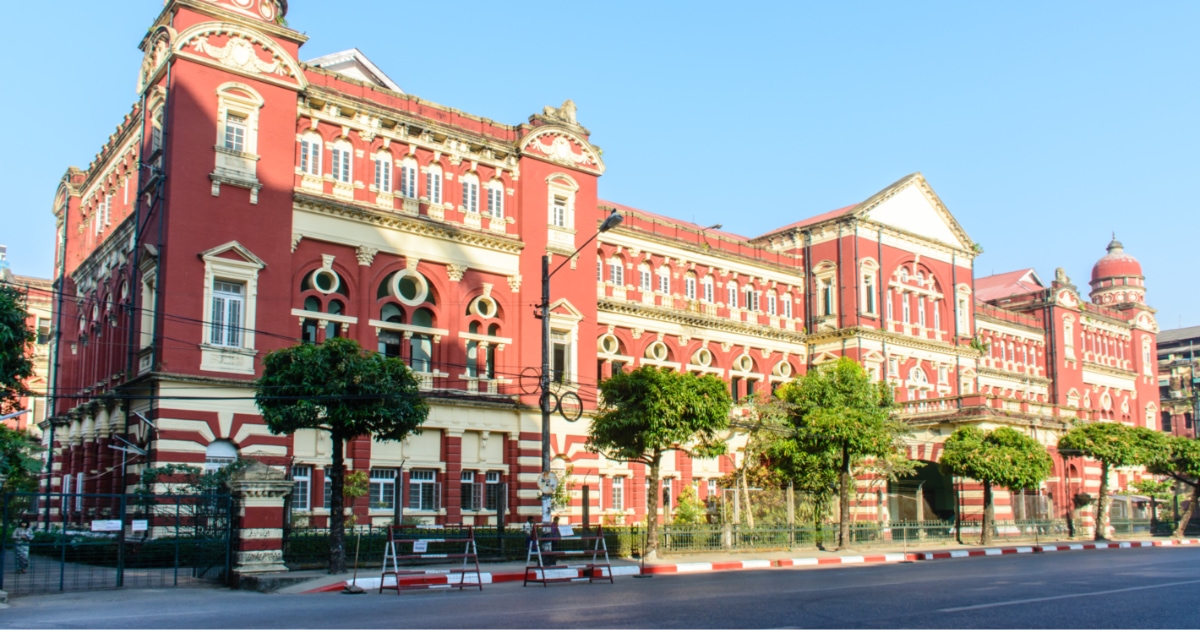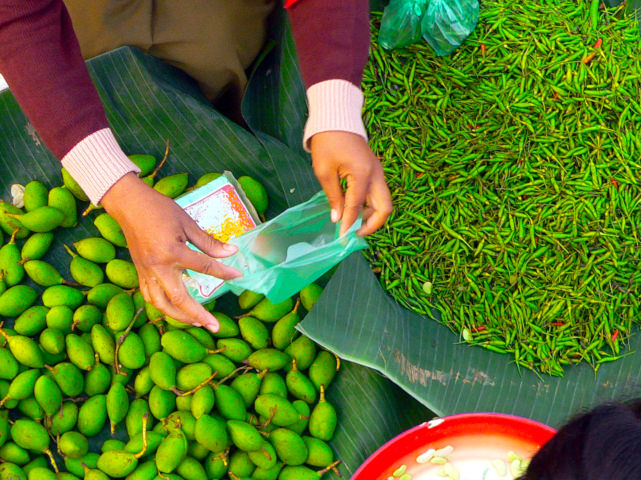Myanmar is in the early stages of financial reforms which the government has made an economic priority. At present Myanmar’s financial system remains one of the least developed in the world. Myanmar remains a cash-oriented economy. A history of high inflation, bank runs, and insider lending has fuelled public distrust of the banking and financial services industry. Even now, government owned banks still have more than U.S. $7 billion of foreign reserves on deposit with overseas banks. It is estimated that less than 10% of Myanmar citizens have a bank account and that less 0.1% of the public are active in the credit market. A large informal banking system in Myanmar still exists. Remittance companies – licenced and unlicensed – remain popular as is the black market for foreign exchange. Myanmar’s financial sector has grown substantially in recent years, but the recent worldwide explosion of financial technology (fintech), including in Myanmar, promises to fill this gap.
The banking sector comprises the Central Bank of Myanmar (CBM) which was established pursuant to the Central Bank of Myanmar Law in 1990, 4 other state-owned banks, and 19 domestic private banks. Currently, the sector consists of 27 private local banks, in addition to the four state-owned banks.
In April 2012 the CBM took the first step towards reforming the country’s exchange rate system when it scrapped the country’s fixed exchange rate in favour of a managed float. On 11 July 2013 the new Central Bank of Myanmar Law (CBM Law) was introduced. The law establishes the independence of the CBM and contains measures aimed at increasing transparency and accountability.
Pursuant to the CBM Law, the State is the sole shareholder of the CBM with an authorized capital of three hundred thousand million kyats, of which one hundred thousand million kyats shall be fully paid up by the State. The CBM is also required to establish a General Reserve. At the end of each year, an amount equal to 40% of the net profits shall be allocated in multiples of million to the General Reserve until it amounts to 100% of the paid-up capital of the CBM. The Head Office of the CBM is in Naypyitaw but the CBM may open branches inside or outside the State with the approval of Board of Directors. Among other things, the CBM Law contains provisions in relation to:-
- Kyat stabilization and issuance;
- Foreign exchange and International Reserves Management;
- Stabilizing the monetary system;
- Management of financial markets, the foreign exchange market, currency payment and settlement of accounts;
- The CBM acting as a lender of last resort.
The CBM is also in the process of developing an Automatic Clearing System and Real Time Gross Settlement System. CBM approval is required to repatriate profits.
Local Myanmar banks are playing their part in reform initiatives by seizing the opportunity to expand their branch network and introduce new financial products. They are also entering into agreements with international credit card providers. Since 2012 the number of ATM’s in Myanmar has increased significantly. CB Bank (CB) and Kanbawza Bank (KBZ) have led the way. Master, Visa and Union Pay cards are accepted. Withdrawals up to $1200 per day are permitted with a maximum limit of USD$360 per transaction. Transaction fees are high. KBZ charges approximately $6 per transaction while CB charges approximately US$5. Machines are frequently out of order for a lack of cash. Aside from certain hotels, businesses generally do not accept credit cards in point of sale (POS) transactions although it is anticipated that POS facilities will become more common.
The reform on Myanmar’s banking sector seems to be increasing with liberalisation towards a major step. The CBM announced on 7 November, 2019 that a new round of foreign bank licensing will be opened to foreign banks with representative offices in Myanmar and this is a third foreign bank licensing exercise conducted by CBM; the previous two rounds were conducted in 2014 and 2016, and granted a total of 13 financial institutions to open a branch and conduct onshore wholesale banking business. Foreign banks can apply either branch licence or subsidiary licence. Started from January 1, 2020 subsidiaries will also be allowed to engage in onshore retail banking services and; to establish up to ten (10) places of business being branches or off-site ATMs.
Prior to this, foreign banks had been limited to conduct banking business in Myanmar. At present according to the CBM, there are 13 foreign bank branches – licensed to operate in a limited capacity started from 2014, 46 representative offices of foreign banks, 7 foreign non-banking institutions with representative offices operating in the country.
Mobile Financial Service Sector
Mobile banking has been emerging as an important impact in financial technology (fintech) as banks have sought to leverage the spread of smartphones with the liberalization of telecom industry in 2014. As part of the government’s reform program, the telecommunications sector was liberalized to attract FDIs, create employment opportunities, support IT development, and promote ICT as a catalyst for social and economic change by enacting the Telecommunications Law as a legal basis on October 8, 2013 in Myanmar. As part of the Myanmar Financial Inclusion Roadmap 2019-2023, Myanmar intended to seek financial solutions relating to digital-driven financial inclusions. On March 2016, the CBM issued the regulations on mobile financial services. To keep pace with the sector’s development in the country, the CBM allowed Mobile Network Operators (MNOs), banks and Non-Bank Financial Institutions (NBFIs) that have received registration certificates from the CBM to provide mobile financial services to offer domestic money transfer and payment services, and kyat-dominated cash in – cash out transactions in the domestic.
There are two licensing procedures granted by the CBM such as Mobile Banking Licence and Mobile Financial Service Licence (MFS licence). The former allows companies to partner with licensed banks (as in the True Money collaboration with AGD); the latter enables non-banking institutions to provide mobile financial services. MNOs and registered non-banking financial institutions can apply for an MFS licence. Many companies have applied for MFS licences. Currently, MFSPs are operating under various licences; for example, the regulator initially followed a telco-led approach (Wave) but then granted an MFS licence to OK Dollar, a financial service provider operating with an MFI licence. Up to 2019 the CBM has been issued the mobile financial service licences: Wave Money, M-Pitesan, OK Dollar, MytelPay and MPT money. In response to increased telecoms penetration rates, Myanmar banks have decided to adopt innovative financial services, such as human contact points- a network of agents around Myanmar where users can deposit and withdraw cash.
Myanmar Economy | Microfinance in Myanmar
Microfinance is a main source of external financing for local MSMEs as well as it is one of the available sources of financing targeted for personal and business funding. In 2011 the government introduced a new Microfinance Law, allowing local MFIs to set up and compete with international MFIs already operating in the country under international NGO flags.
The new law’s objectives are to:-
- reduce the poverty;
- develop the social, education, health opportunities among the “grass roots” (defined as “low-income farmers, labors and vendors who reside in rural and urban areas”);
- create job opportunities;
- encourage a ‘savings’ culture;
- encourage the emergence of new small-scaled businesses;
- to improve incomes in the agricultural sector and to encourage livestock breeding;
- to help improve technical know-how.
The law provides for the establishment of a Microfinance Development Working Committee (Committee). Among other things the Committee is empowered to scrutinise an application by a micro-finance charity or micro-finance institutions proposing to carry out micro-financing, and prescribe the formats of accounts and report obligations for such institutions. A separate Supervisory Committee shall grant licenses to institutions involved in microfinance in Myanmar. In addition, the Myanmar Microfinance Association (MMFA) was also established in 2013 to advance the sector’s improvement and interests. The Microfinance Institutions (MFIs) can also work in both rural and urban areas; and they were allowed to apply for deposit-taking licences, borrow from international and local financial institutions, and issue loans up to a new limit MMK10 million. Now in Myanmar, around 180 MFIs have been permitted the licence to operate, with the largest of these operated by international NGOs and MFI groups.







